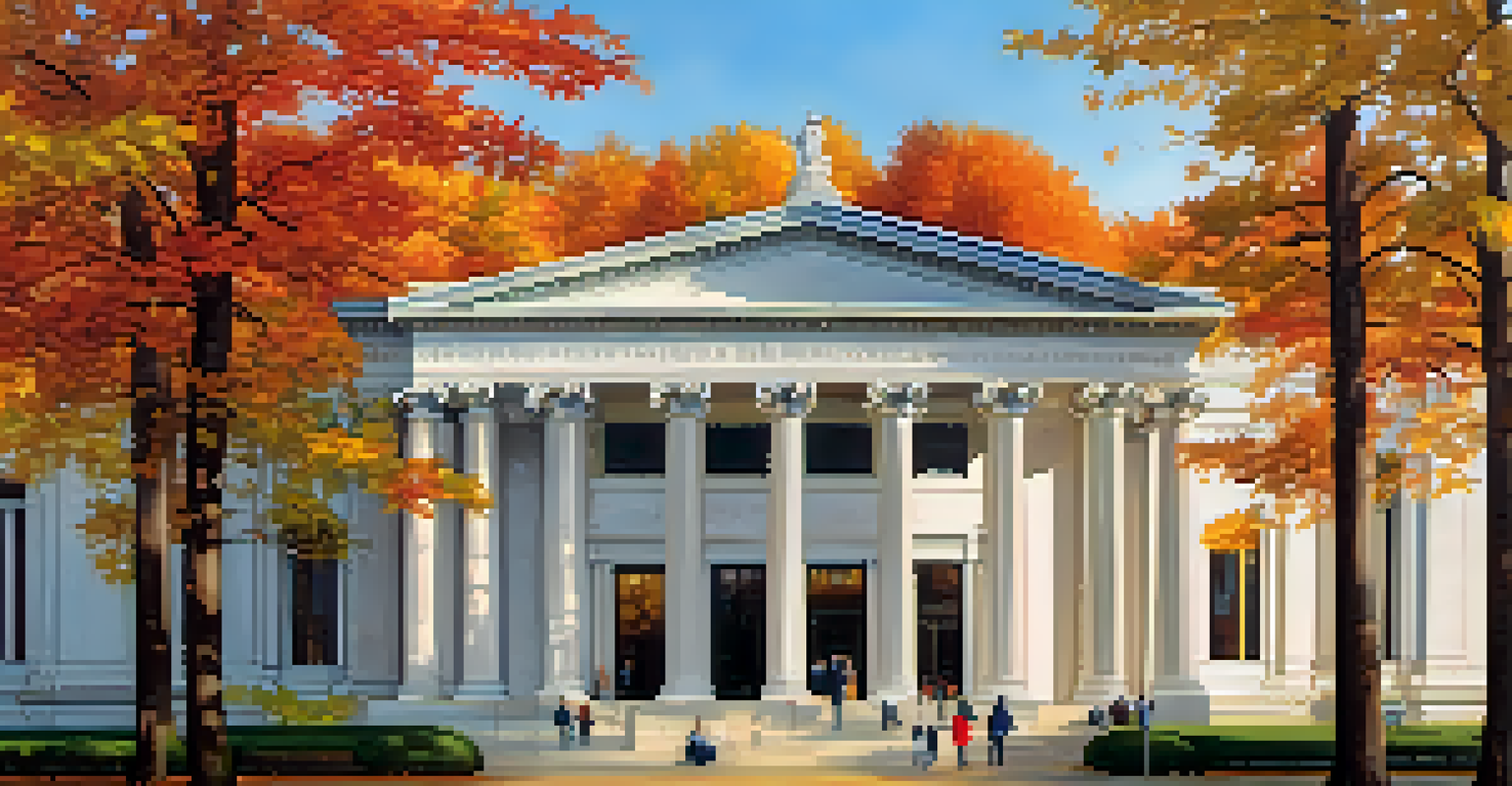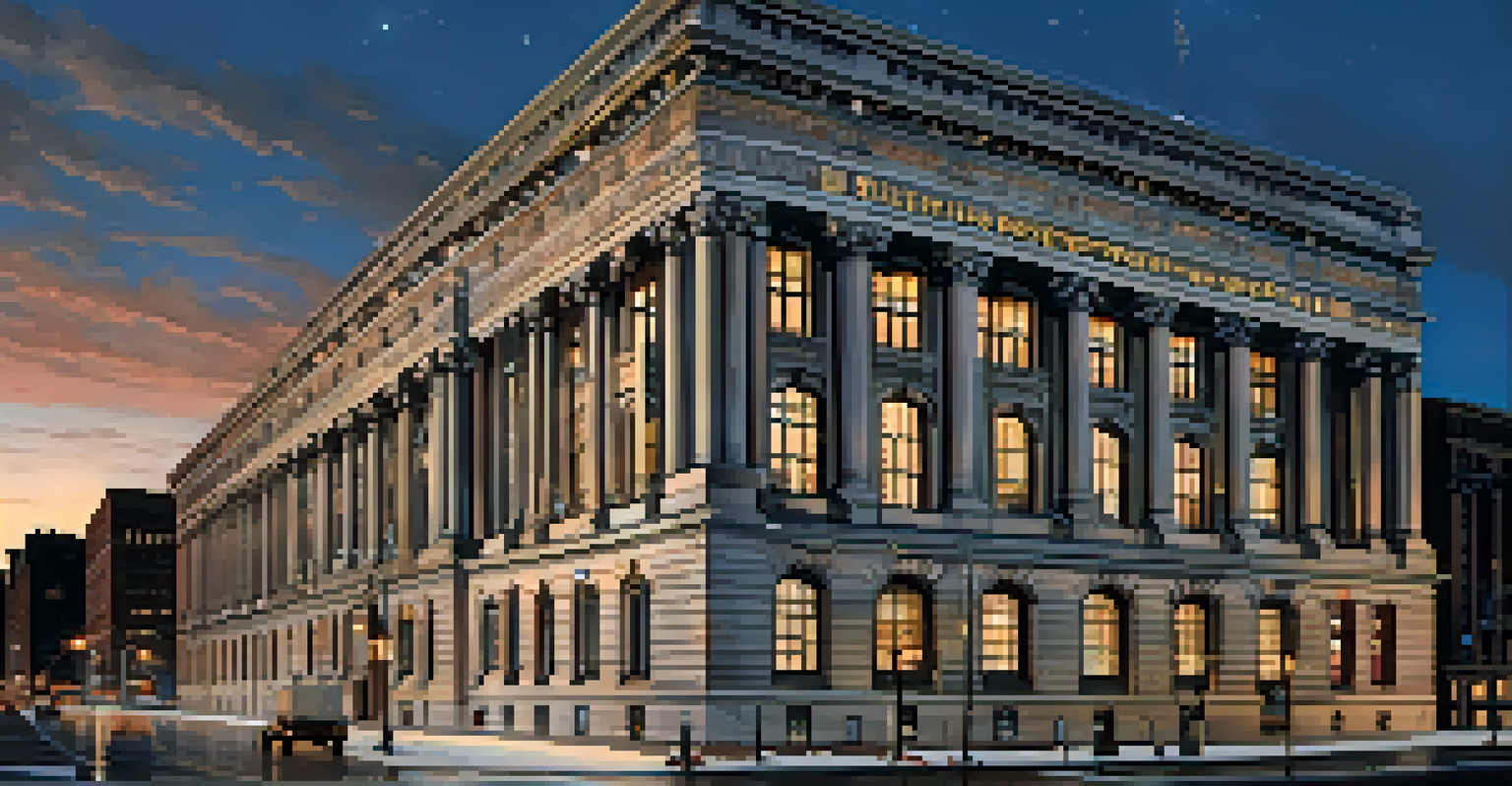The Influence of Beaux-Arts Architecture in Buffalo's Design

Understanding Beaux-Arts Architecture: A Brief Overview
Beaux-Arts architecture emerged in the late 19th century, blending classical elements with grand designs. Characterized by its symmetry, elaborate details, and monumental scale, this style sought to create buildings that exuded elegance and sophistication. In cities like Buffalo, Beaux-Arts became synonymous with progress and ambition, reflecting the prosperity of the era.
Architecture is the learned game, correct and magnificent, of forms assembled in the light.
The term 'Beaux-Arts' translates to 'fine arts' in French, emphasizing the artistic aspect of this architectural style. Influenced by the teachings at the École des Beaux-Arts in Paris, architects learned to combine aesthetics with functionality. This educational background equipped them to create iconic structures that still resonate today.
Buffalo’s embrace of Beaux-Arts architecture marked a pivotal moment in its urban development. With its rich history and cultural significance, the city became a canvas for architects to express their vision through this grand style. This foundation laid the groundwork for Buffalo's architectural identity that we continue to admire.
Key Beaux-Arts Structures in Buffalo You Should Know
Buffalo is home to several stunning examples of Beaux-Arts architecture, most notably the Buffalo City Hall. Completed in 1931, this towering structure features a distinctive clock tower and intricate stonework, embodying the essence of the style. Its grandeur makes it a focal point in the city's skyline and a symbol of Buffalo's civic pride.

Another remarkable example is the Albright-Knox Art Gallery, which showcases the blending of classical design with modern art. Its Beaux-Arts elements, like the grand entrance and decorative friezes, invite visitors to explore both its architecture and its impressive art collection. This fusion of the old and the new highlights the versatility of the Beaux-Arts style.
Beaux-Arts: A Symbol of Civic Pride
Beaux-Arts architecture in Buffalo reflects the city’s ambition and serves as a testament to its rich cultural heritage.
Lastly, the Buffalo Post Office is another significant Beaux-Arts building, known for its imposing façade and spacious interior. Designed to accommodate the growing needs of the city, this structure reflects the ambition of Buffalo during its industrial peak. Each of these buildings tells a story, weaving together the city’s past with its architectural legacy.
The Cultural Significance of Beaux-Arts in Buffalo
Beaux-Arts architecture in Buffalo is not just about aesthetics; it represents a cultural ethos of its time. The construction of grand public buildings was a statement of civic pride and an indication of Buffalo's aspirations as a major urban center. These structures served as gathering places, fostering community engagement through their design and purpose.
We shape our buildings; thereafter they shape us.
As Buffalo transitioned through various economic phases, the Beaux-Arts buildings remained symbols of resilience and ambition. They were designed to inspire awe and admiration, reinforcing the idea that architecture can elevate the human experience. Their presence in the city continues to evoke a sense of nostalgia and pride among residents.
Today, these architectural treasures are celebrated not only for their beauty but also for their historical importance. They serve as a reminder of Buffalo's rich heritage and the vision of those who built them. This cultural significance makes Beaux-Arts architecture a crucial part of Buffalo’s identity.
The Architectural Elements of Beaux-Arts Style
Beaux-Arts architecture is characterized by its grand scale and elaborate detailing. Key elements include monumental staircases, grand columns, and intricate ornamentation. These features work together to create a sense of drama and importance, making buildings feel larger than life.
Another defining characteristic is the use of symmetry and classical proportions, which create a balanced and harmonious appearance. This meticulous attention to detail not only enhances the visual appeal but also reflects the architectural principles taught at the École des Beaux-Arts. Each building tells a story through its design, inviting viewers to appreciate its craftsmanship.
Preservation Efforts for Architectural Gems
Ongoing initiatives aim to restore and maintain Beaux-Arts buildings, highlighting their historical significance and craftsmanship.
Buffalo’s Beaux-Arts buildings often incorporate local materials, blending the grandeur of the style with the city’s unique identity. This connection to the local environment adds depth to the architectural narrative, showcasing how global influences can harmonize with regional characteristics. Such thoughtful design choices contribute to the city’s rich architectural tapestry.
The Revival of Interest in Beaux-Arts Architecture
In recent years, there has been a renewed interest in Beaux-Arts architecture, both in Buffalo and beyond. As communities recognize the value of preserving historical structures, many are advocating for the restoration of these architectural gems. This movement reflects a broader trend toward valuing heritage and sustainability in urban development.
Buffalo has seen several initiatives aimed at restoring and maintaining its Beaux-Arts buildings. Preservation efforts not only protect the architectural integrity of these structures but also celebrate the city’s history. By investing in their upkeep, Buffalo is reinforcing its commitment to honoring the past while looking toward the future.
The revival of interest in Beaux-Arts architecture is also fueled by a growing appreciation for craftsmanship and artistry in building design. As contemporary architecture often leans toward minimalism, Beaux-Arts offers a refreshing contrast with its ornate details and grand narratives. This appreciation helps ensure that future generations will continue to cherish and learn from these architectural masterpieces.
Challenges Facing Beaux-Arts Buildings Today
Despite their beauty and historical significance, Beaux-Arts buildings in Buffalo face several challenges. Aging infrastructure, changing urban landscapes, and financial constraints can threaten their preservation. Many structures require significant investment to maintain their grandeur while adapting to modern needs.
Another challenge lies in balancing the need for modernization with the desire to preserve original architectural features. As cities evolve, it becomes crucial to find solutions that respect the historical context of these buildings while accommodating contemporary use. This delicate balance can be difficult to achieve, requiring collaboration between architects, preservationists, and the community.
Challenges in Modernization and Awareness
Beaux-Arts structures face challenges like aging infrastructure and the need for public appreciation to ensure their preservation.
Additionally, public awareness and appreciation of Beaux-Arts architecture can sometimes wane. As new generations emerge, it’s essential to educate them about the value of these structures and their role in the city’s history. By fostering a sense of pride and ownership, Buffalo can ensure that its Beaux-Arts heritage continues to be celebrated for years to come.
The Future of Beaux-Arts Architecture in Buffalo
Looking ahead, the future of Beaux-Arts architecture in Buffalo holds promise, thanks to ongoing preservation efforts and community engagement. As more people recognize the importance of these structures, there is a growing movement to protect and celebrate them. This renewed appreciation can lead to increased funding and support for restoration projects.
Moreover, integrating Beaux-Arts architecture into modern urban planning can create a vibrant dialogue between the past and the present. By incorporating these architectural treasures into new developments, Buffalo can maintain its historical character while embracing innovation. This synergy can enrich the city’s cultural landscape and attract visitors.

Ultimately, the future of Beaux-Arts architecture in Buffalo depends on the collective efforts of its residents, preservationists, and city planners. By championing these architectural gems, Buffalo can not only honor its past but also inspire future generations to appreciate and protect their cultural heritage. The journey forward will be as beautiful and intricate as the buildings themselves.